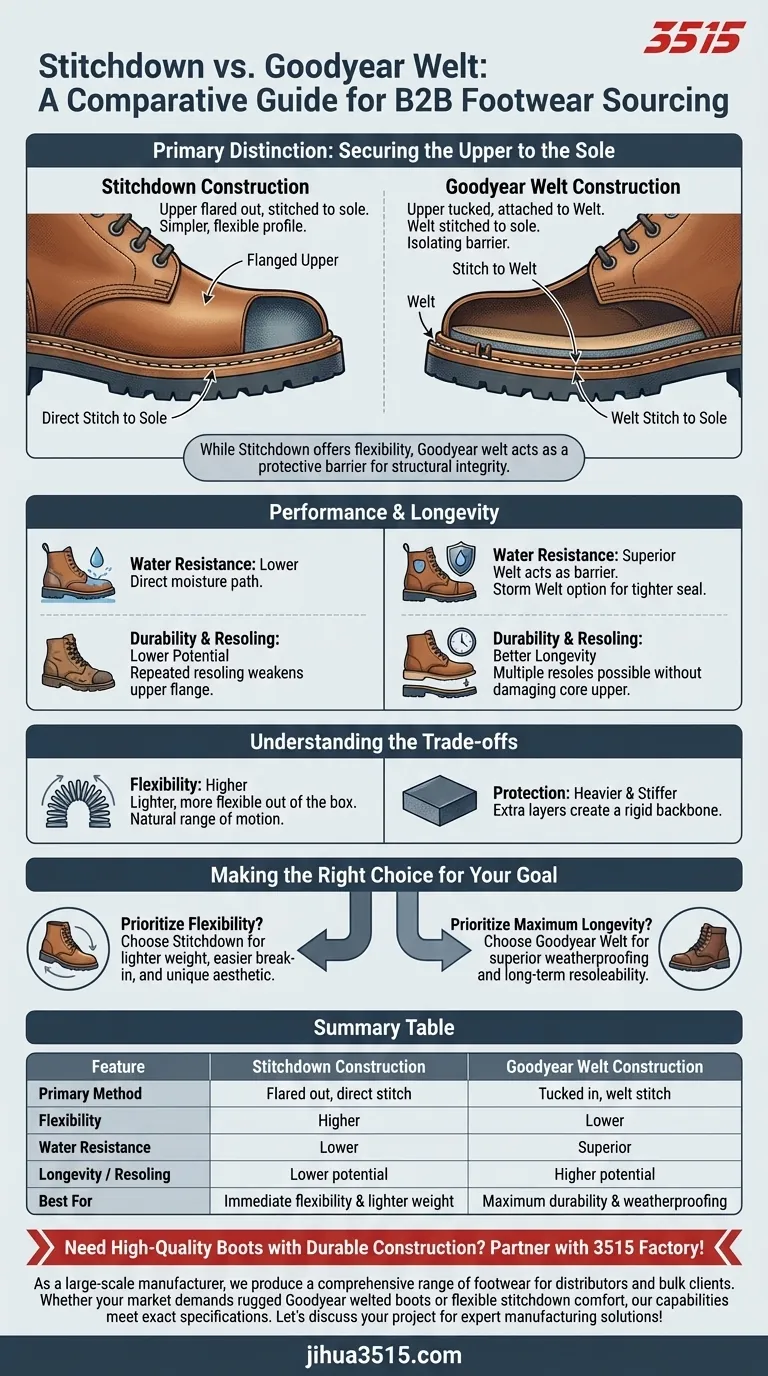The primary distinction lies in how the leather upper is secured to the sole. In Stitchdown construction, the upper material is flared outward and stitched directly to the outsole or midsole. Conversely, Goodyear welt construction tucks the upper underneath the insole and attaches it to an intermediate strip of leather (the welt), which is then stitched to the sole, isolating the upper from the ground.
While Stitchdown construction offers superior flexibility and a simpler profile, the Goodyear welt acts as a protective barrier, offering greater water resistance and long-term structural integrity.

The Mechanics of Construction
The Stitchdown Flange
In this method, the leather of the boot’s upper is flanged outward rather than tucked under.
This creates a visible rim of leather around the base of the shoe. Because the upper is stitched directly to the sole unit, the construction is relatively simple and robust.
The Goodyear Intermediary
Goodyear welting is defined by the use of an intermediate component—the welt.
The upper is not attached directly to the outsole. Instead, it is stitched to the welt, and the welt is subsequently stitched to the outsole. This creates a multi-layered buffer between your foot and the elements.
Performance and Longevity
Water Resistance Capabilities
According to industry standards, Goodyear welt construction generally offers superior water resistance.
The presence of the welt acts as a physical barrier, preventing water from seeping directly into the insole cavity. Some variations, such as the Storm Welt, use a wider welt bent upwards to create an even tighter seal against moisture.
Durability and Value
Goodyear-welted footwear is widely regarded as providing better longevity.
Because the sole is stitched to the welt rather than the upper, a cobbler can replace the sole repeatedly without damaging the core structure of the leather upper. This ease of resoling significantly extends the total lifespan of the boot.
Understanding the Trade-offs
Flexibility vs. Protection
While Goodyear welts offer protection, they are typically heavier and stiffer due to the extra layers of material.
Stitchdown construction, by attaching directly to the sole, often results in a boot that is more flexible right out of the box. It lacks the rigid "backbone" of a Goodyear welt, allowing for a more natural range of motion earlier in the break-in process.
The Limits of Stitchdown
While durable, Stitchdown construction has lower potential longevity compared to Goodyear welting.
Because the stitch passes directly through the upper leather to hold the sole, repeated resoling can eventually weaken the leather flange. Furthermore, without the protective welt, moisture has a more direct path to the interior of the boot.
Making the Right Choice for Your Goal
To select the correct construction, you must prioritize between immediate comfort and maximum lifespan.
- If your primary focus is Maximum Longevity: Choose Goodyear welt construction for its superior water resistance and the ability to be resoled multiple times without compromising the upper.
- If your primary focus is Flexibility: Choose Stitchdown construction for a boot that is lighter, bends more easily with your foot, and offers a unique visual aesthetic.
Ultimately, the right construction depends on whether you value a lighter, flexible feel over the absolute maximum weatherproofing and resoling potential.
Summary Table:
| Feature | Stitchdown Construction | Goodyear Welt Construction |
|---|---|---|
| Primary Method | Upper flared outward & stitched directly to sole | Upper stitched to a welt, which is then stitched to sole |
| Flexibility | Higher (more flexible out of the box) | Lower (stiffer due to extra layers) |
| Water Resistance | Lower | Superior (welt acts as a barrier) |
| Longevity / Resoling | Lower potential (re-soling can weaken upper) | Higher potential (can be resoled many times) |
| Best For | Prioritizing immediate flexibility & lighter weight | Prioritizing maximum durability & weatherproofing |
Need High-Quality Boots with Durable Construction? Partner with 3515 Factory!
As a large-scale manufacturer, 3515 produces a comprehensive range of footwear for distributors, brand owners, and bulk clients. Whether your market demands the rugged longevity of Goodyear welted boots or the flexible comfort of stitchdown construction, our production capabilities encompass all types of shoes and boots to meet your exact specifications.
Let's discuss your project and how we can bring your vision to life. Contact our team today for expert manufacturing solutions!
Visual Guide

Related Products
- Durable Goodyear Welt Leather Work Boots for Wholesale & Private Label
- Wholesale Leather Work Boots with Customizable Wedge Sole for Brands
- Durable Leather Work Boots for Wholesale & Custom OEM Manufacturing
- Durable Leather Work Boots for Wholesale & Custom Manufacturing
- Wholesale Durable Leather Work Boots | 8-Inch Goodyear Welt Manufacturer
People Also Ask
- What does ASTM F2413-18 standard cover? Your Guide to U.S. Safety Toe Footwear Ratings
- What are the cultural perspectives on wearing shoes in the house? A Guide to Home Etiquette & Hygiene
- What is the significance of impact resistance (IR) in safety boots? Protect Your Feet from Severe Injuries
- Why is the last important in work boot design? It's the Anatomical Blueprint for Comfort & Safety
- Which material is the most durable for work boots? Find the Right Boot for Your Job



















